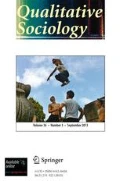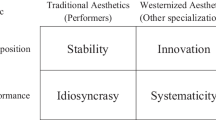Abstract
Much of the literature on production in cultural fields has been dominated by gatekeeper and rational-actor narratives. These literatures argue that the production of art objects tends to be driven by competition for status within fields and by institutional forces that shape how actors produce their work and define success. While much of the existing research has provided insight on the structural determinants that organize the opportunity structures within cultural fields, much less is known about how cultural producers make sense of the competitive prize-seeking bound up in professional integration. This article examines the role that juried prizes and competitions play in shaping how cultural producers understand who they are and what they do as artists seeking professional integration in their fields. Drawing on 41 semi-structured, in-depth interviews with contemporary art music composers in the early stages of their careers, the article shows how composers engage in self-curation strategies that seek to mitigate the uncertainty of selection associated with competition participation. The article discusses three additional findings. First, composers participate in different competition types and make decisions about which types are best suited for achieving their professional goals. Second, self-curation strategies map on to different aspects of composer’s self-concepts and the actions warranted by these differences. Third, composers move within and across three different self-curation strategies outlined in the article. By engaging these strategies, it is argued that composers come to understand competitions as meaningful in their efforts to professionalize and as mechanisms through which they reconcile legibility within the field with an authentic pursuit of their artistic voice. This research locates self-curation as a phenomenon at the intersection of rational and meaning-centered action.
Similar content being viewed by others
Notes
McCormick is referring primarily to competition events that feature performances by instrumentalists and vocalists performing existing compositions that have, in many cases, been canonized by classical music intermediaries.
Data on composers who are members of minority groups was obtained from the Institute for Composer Diversity website www.composerdiversity.com.
Lists of winners and judging panels, along with the competition rules and procedures are made available each year on the contest website www.bmifoundation.org.
Information regarding selection, eligibility, and contest rules are available on the Kaleidoscope Chamber Orchestra website: www.kco.la.
See composer Alex Shapiro’s article regarding composer competitions that addresses how competitions factor into university faculty evaluations at https://nmbx.newmusicusa.org/dissing-the-competition/.
References
Alexander, Jeffrey C. 2006. The civil sphere. New York: Oxford University Press.
Allen, Michael Patrick, and Anne E. Lincoln. 2004. Critical discourse and the cultural consecration of American films. Social Forces 82 (3): 871–894.
Allen, Michael Patrick, and Nicholas L. Parsons. 2006. The institutionalization of fame: Achievement, recognition and cultural consecration in baseball. American Sociological Review 71: 808–825.
Becker, Howard S. 1974. Art as collective action. American Sociological Review 39 (6): 767–776.
Becker, Howard S. 1982. Art words. Berkeley: University of California Press.
Benzecry, Claudio. 2009. Becoming a fan: On the seductions of opera. Qualitative Sociology 32 (2): 131–151.
Born, Georgina. 1995. Rationalizing culture: IRCAM, Boulez, and the institutionalization of the musical avant-garde. Berkeley: University of California Press.
Born, Georgina. 2010. The social and the aesthetic: For a post-Bourdieuian theory of cultural production. Cultural Sociology 4 (2): 171–208.
Born, Georgina. 2011. Music and the materialization of identities. Journal of Material Culture 16 (4): 376–388.
Bourdieu, Pierre. 1971. Intellectual field and creative project. In Knowledge and control: New directions for the sociology of education, ed. M. Young. London: Collier MacMillan.
Bourdieu, Pierre. 1993. The field of cultural production. New York: Columbia University Press.
Bourdieu, Pierre. 1996. The rules of art: Genesis and structure of the literary field. Palo Alto: Stanford University Press.
Bureau, Sylvain, and Ivo Zander. 2014. Entrepreneurship as an art of subversion. Scandinavian Journal of Management 30: 124–133.
Cattani, Gino, Simone Ferriani, and Paul D. Allison. 2014. Insiders, outsiders, and the struggle for consecration in cultural fields: A core-periphery perspective. American Sociological Review 79 (2): 258–281.
Collins, Randall. 1998. The sociology of philosophies: A global theory of intellectual change. Cambridge, MA: Harvard University Press.
Crane, Diana. 1976. Reward systems in art, science, and religion. American Behavioral Scientist 19: 719–734.
De la Fuente, Eduardo. 2008. The art of social forms and the social forms of art: The sociology-aesthetics nexus in Georg Simmel’s thought. Sociological Theory 26 (4): 344.
De Nora, Tia. 1995. Beethoven and the construction of genius: Musical politics in Vienna, 1792–1803. Berkeley: University of California Press.
Demers, Joanna. 2010. Listening through the noise: The aesthetics of experimental electronic music. New York: Oxford University Press.
DeNora, Tia. 2000. Music in everyday life. Cambridge, UK: Cambridge University Press.
DiMaggio, Paul. 1982. Cultural entrepreneurship in 19th century Boston: The creation of an organizational base for high culture in America. In Rethinking popular culture: Contemporary perspectives in cultural studies, eds. Chandra Mukerji and Michael Schudson, 347–397. Berkeley: University of California Press.
DiMaggio, Paul. 2011. Cultural networks. In The Sage handbook of social network analysis, ed. John Scott and Peter J. Carrington, 286–300. London: Sage Publications.
Durand, Rodolphe, and Pierre-Antoine Kremp. 2016. Classical deviation: Organizational and individual status as antecedents of conformity. Academy of Management Journal 59 (1): 65–89.
Elias, Norbert. 1993. Mozart: Portrait of a genius. Berkeley: University of California Press.
English, James. 2005. The economy of prestige: Prizes, awards and the circulation of cultural value. Cambridge, MA: Harvard University Press.
Espeland, Wendy, and Michael Sauder. 2007. Rankings and reactivity: How public measures recreate social worlds. American Journal of Sociology 113 (1): 1–40.
Eyerman, Ronald, and Lisa McCormick, eds. 2006. Myth, meaning, and performance: Toward a new cultural sociology of the arts. New York: Routledge.
Fine, Gary Allen. 2018. Talking art: The culture of practice, the practice of culture. Chicago: University of Chicago Press.
Frey, Bruno S. 1997. Not just for the money: An economic theory of personal motivation. Cheltenham: Edward Elgar Publishing Limited.
Gerber, Alison. 2017. The work of art: Value in creative careers. Palo Alto: Stanford, University Press.
Gerber, Alison. 2019. Black hole suns: Binarism and gravity in cultural fields. Culture Unbound. Linköping University Electronic Press. http://www.cultureunbound.ep.liu.se. https://doi.org/10.3384/cu.2000.1525.191217a
Goode, William J. 1978. The celebration of heroes: Prestige as a social control system. Berkeley: University of California Press.
Gottschalk, Jennie. 2016. Experimental music since 1970. New York: Bloomsbury Academic Press.
Gross, Neil. 2002. Becoming a pragmatist philosopher: Status, self-concept and intellectual choice. American Sociological Review 67 (1): 52–76.
Hennion, Antoine. 2007. Those things that hold us together: Taste and sociology. Cultural Sociology 1 (1): 97–114.
Hirsch, Paul M. 1972. Processing fads and fashions: An organization-set analysis of cultural industry systems. American Journal of Sociology 77 (4): 639–659.
Kadushin, Charles. 1969. The professional self-concept of music students. American Journal of Sociology 75 (3): 389–404.
Karpik, Lucien. 2010. Valuing the unique: The economics of singularities. Princeton: Princeton University Press.
Klett, Joseph, and Alison Gerber. 2014. The meaning of indeterminacy: Noise music as performance. Cultural Sociology 8 (3): 275–290.
Kremp, Pierre-Antoine. 2010. Innovation and selection: Symphony orchestras and the construction of the musical canon in the United States (1879–1959). Social Forces 88: 1051–1082.
Lena, Jennifer C. 2012. Banding together: How communities create genres in popular music. Princeton: Princeton University Press.
Leschziner, Vanina. 2015. At the chef’s table: Culinary creativity in elite restaurants. Palo Alto: Stanford University Press.
Lingo, Elizabeth L., and Steven J. Tepper. 2013. Looking back, looking forward: Art-based careers and creative work. Work and Occupations 40 (4): 337–363.
McAndrew, Siobhan, and Martin Everett. 2015. Music as collective invention: A social network analysis of composers. Cultural Sociology 9 (1): 56–80.
McCormick, Lisa. 2015. Performing civility: International competitions in classical music. Cambridge, UK: Cambridge University Press.
Menger, Pierre-Michel. 1999. Artistic labor markets and careers. Annual Review of Sociology 25: 541–574.
Menger, Pierre-Michel. 2014. The economics of creativity: Art and achievement under uncertainty. Cambridge, MA: Harvard University Press.
Merton, Thomas K. 1968. The Matthew effect in science. Science 59 (3810): 56.
Peterson, Richard A., and N. Anand. 2004. The production of culture perspective. Annual Review of Sociology 30: 311–334.
Prior, Nick. 2008. Putting a glitch in the field: Bourdieu, actor network theory, and contemporary music. Cultural Sociology 2 (3): 301–319.
Pugh, Allison J. 2013. What good are interviews for thinking about culture? Demystifying interpretive analysis. American Journal of Cultural Sociology 1: 42–68.
Rossman, Gabriel, and Oliver Schilke. 2014. Close, but no cigar: The bimodal rewards to prize-seeking. American Sociological Review 79 (1): 86–108.
Rutherford-Johnson, Tim. 2017. Music after the fall: Modern composition and culture since 1989. Berkeley: University of California Press.
Shusterman, Richard. 2000. Pragmatist Aesthetics: Living beauty, Rethinking art. Lanham, MD. Rowman & Littelfield Publishers, Inc.
Wilf, Eitan. 2014. School for cool: The academic jazz program and the paradox of institutionalized creativity. Chicago: University of Chicago Press.
Wohl, Hannah. 2015. Community sense: The cohesive power of aesthetic judgement. Sociological Theory 33 (4): 299–326.
Wohl, Hannah. 2019. Creative visions: Presenting aesthetic trajectories in artistic careers. Poetics 76: 101358. https://doi.org/10.1016/j.poetic.2019.03.003.
Wolff, Janet. 1983. Aesthetics and the sociology of art. Ann Arbor: University of Michigan Press.
Acknowledgements
Thank you to Isaac Ariail Reed, Fiona Greenland, Sabrina Pendergrass, Stephan Fuchs, Hannah Wohl, Saundra M. Henderson, and the participants of the Sociological Working group on Aesthetics, Meaning, and Power (SWAMP) at the University of Virginia for their invaluable commentary and suggestions. Thank you also to the reviewers and to each of the interview participants who contributed to this research.
Funding
This research received no financial support from any organizations in the public, commercial, or not-for-profit sectors.
Author information
Authors and Affiliations
Corresponding author
Additional information
Publisher’s Note
Springer Nature remains neutral with regard to jurisdictional claims in published maps and institutional affiliations.
Rights and permissions
About this article
Cite this article
Sutton, A.C. The Composition of Success: Competition and the Creative Self in Contemporary Art Music. Qual Sociol 43, 489–513 (2020). https://doi.org/10.1007/s11133-020-09465-w
Published:
Issue Date:
DOI: https://doi.org/10.1007/s11133-020-09465-w




